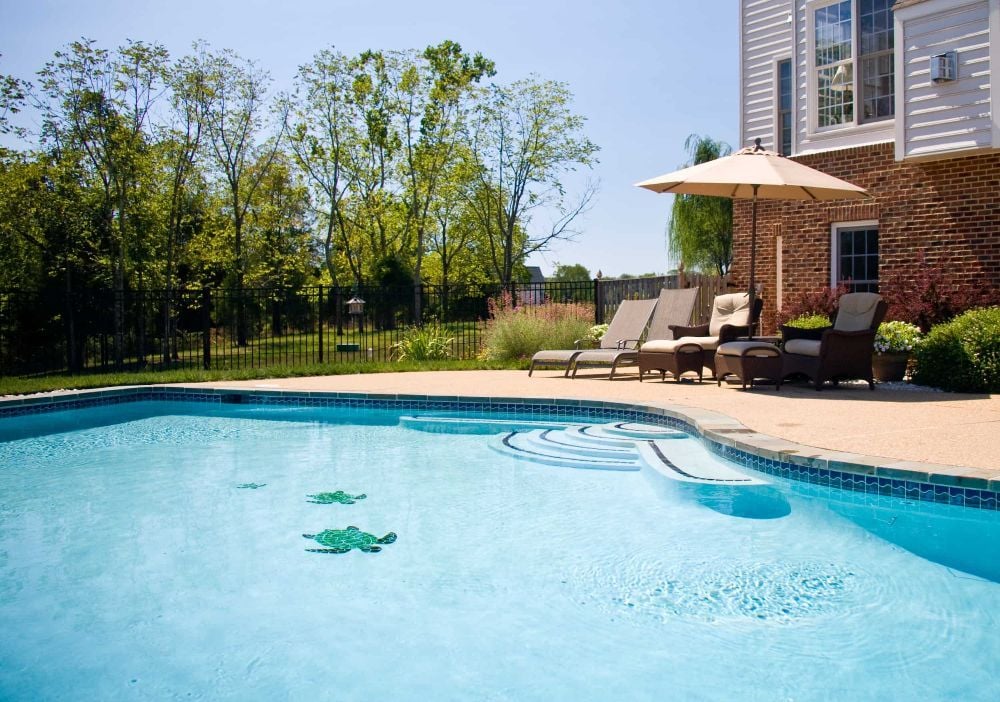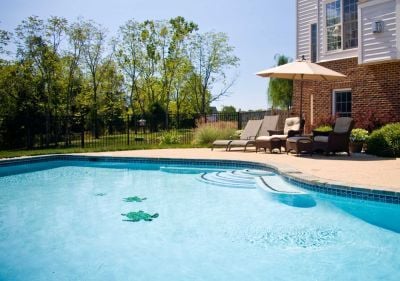
Learn about how concrete leveling can help you keep the concrete around your pool looking great and functioning the way it should.
If you’ve found yourself with trip hazards or other problems with the concrete around your pool, you have options for its repair. Concrete leveling is a fast and cost-effective solution to many of the issues that occur around pools, and it just might be the fix you need to get your pool area back to its best.
A-1 Concrete Leveling has been lifting sunken concrete slabs for over 30 years, and throughout this time, we’ve gotten to know a thing or two about pools and concrete leveling.
In this article, we’ll walk you through everything from why concrete problems around pools are common to frequently asked questions about concrete leveling around pools.
Why Concrete Problems Around Pools Are Common
Concrete settling around a pool is a very common issue. When a pool is installed, the soil and material around it get disturbed, and it is very tricky to get close enough to the edge of the pool to compact it properly before installing the concrete pool deck.
When concrete is placed on top of this uncompacted soil or other material, over time, the slabs will settle or voids will open up as the sub-material begins to compact, creating trip hazards around your pool.
Concrete leveling is a great solution to this problem because it’s a fast and cost-effective repair that allows you to keep using your pool all summer long, doesn’t tear up your yard or landscaping, and can prevent you from needing to repair the pool liner.
The Most Common Concrete Leveling Pool Repairs
Here at A-1 Concrete Leveling, we do concrete leveling repairs around pools frequently. The following scenarios are what we get called to repair most often:
-
Trip hazards
The last thing you want around your pool is an easy place for your family or guests to trip and fall. When concrete settles around pools, it can create a trip hazard, and we are often called to reduce these hazards. smooth it out and make the area safe again.
-
Plastic/Fiberglass steps flexing
Sometimes the plastic steps leading into your pool can begin flexing or bowing. This is an issue we get called about frequently, and it is usually caused by voids forming under the steps.
Pumping our concrete leveling solution into the empty space under the steps can fill it and stabilize the step. Depending on the condition of the steps, however, additional fiberglass repair may be necessary.
-
Major pool revamp
If you’ve let the maintenance or appearance of your pool go for a while, you may want to do an entire revamp of the area. Many of our customers call because they want to do a major project on their pool, or they want to get their concrete lifted at the same time they get a new liner installed or the pool deck resurfaced.
-
Damage to coping
We often get calls to level concrete when the coping is damaged or the concrete is starting to pull on it. Pool coping is what sits on top of the pool wall and meets the pool deck to form the edge of the pool, and it holds the pool lining in place on vinyl liner pools.
As the concrete settles, it can cause the coping to separate from the concrete over time, or cause the liner to detach and/or tear away from the coping.
-
Voids under concrete
Big empty spaces under the concrete itself are a problem that we also often get called to address. These voids under the slabs can occur because of a water issue, or due to the new soil around the pool settling, and they cause the slabs of the pool deck to become unlevel.

Why Concrete Leveling is Great Around Pools
Concrete leveling is a great option for repairing the concrete around pools for many reasons. Here is a list of the top benefits of using concrete leveling around pools:
-
Avoids replacement
Rather than having to tear out sections of concrete and replace them, concrete leveling lifts the existing slabs and recovers them to as close to their original position as possible.
This allows you to avoid the hassle, mess, and time it takes to replace sunken concrete, and keep your pool up and running during those hot summer months.
-
More control
The A-1 Concrete Leveling method uses less pressure to lift settled concrete when compared to other concrete leveling methods, like mudjacking, for example.
Because there is less pressure involved in the repair, it allows our team to have more control, put less pressure on the pool walls, and be able to monitor areas of concern more closely.
-
Accessibility
To do concrete leveling repairs, we don’t need large equipment making a mess of your pool, or big concrete trucks tearing up your yard.
Instead, we use a single concrete leveling truck that can park in your driveway and pump our leveling compound right to the problem area in your pool deck, which makes concrete leveling very accessible.
Areas of Caution
When lifting settled concrete around pools, we take extra precautions around these particular areas:
-
Coping
Pool coping is not supposed to move in the first place, so during a concrete leveling repair, we have to make sure it stays lined up and in the right position.
If you see that your pool coping is starting to shift or move, you shouldn’t wait to get it fixed. Addressing the issue as soon as possible will help preserve it.
-
Pool Wall
It’s important to take care when leveling around the walls of the pool, as adding too much concrete leveling compound can push against the walls, causing them to bulge.
One measure we take to ensure a safe and effective repair is to only lift pool decks when the pool is full. The pressure of the water pushing back from inside the pool helps prevent potential issues.
It’s also important to keep in mind that many pools have plastic/fiberglass walls which can become more brittle as they age and crack over time. This is not normally an issue, but it can cause significant damage if cracking occurs during a pool deck lift.
-
Plumbing and Pool Skimmers
Like pool coping, once pool skimmers and plumbing are installed, they’re not intended to move. Because the pool skimmer is tied into the pool deck, if the pool deck settles and the plumbing doesn’t settle with it, a leak can form.
At times, the downward pressure from the settling concrete will keep the leak from being significant, but if the slab is lifted and that pressure is relieved, it may become more noticeable and need to be repaired.
Frequently Asked Questions
-
Do I need to worry about pipes?
No, the plumbing and pipes around your pool will not be impacted by concrete leveling.
In order to lift your settled concrete, we drill through the slab and stop at the surface of the soil underneath it. Then, we pump our leveling compound through the hole in the slab, lifting it back to a level position.
Because the pipes are buried in the soil, our equipment doesn’t come in contact with them. However, it’s important to let your concrete leveling team know if you have any special water features, like fountains or waterfalls, directly below or inside the concrete itself.
-
Can you level around all types of pools?
Yes, concrete leveling can be done around concrete, fiberglass, and vinyl liner pools.
-
Can you lift pool equipment pads?
Yes, sunken pool equipment pads can also be lifted with concrete leveling.
-
Should I level my concrete before I do other pool projects?
Yes, it is important to lift unlevel concrete before any pool lining or plumbing work is done.
It’s especially important to make sure your concrete is leveled before installing a new pool liner, as you want the coping that holds it in place to match where concrete meets the edge of the pool.
-
Can my concrete be leveled while the pool is full?
Yes, the concrete around your pool can be leveled while the pool is full. In fact, the pool will need to be full in almost every repair situation because the pressure of the water pushing back from inside the pool helps prevent potential issues with the lift.
One exception to this rule is when pool steps are being stabilized, as the pool needs to be drained in order to have full access to the steps themselves.
Now what?
If you have a problem with the concrete around your pool, you now know that concrete leveling can be a good option for its repair.
If you’re interested in a free consultation and pricing estimate for your pool deck or other problem areas, click the link below to fill out a request form!
Want to learn more? Check out our additional resources in the Learning Center or click the links below:
Sarah Etler joined A-1 Concrete Leveling after receiving her Bachelor of Arts degree in English from Northern Kentucky University. As A-1's Content Marketing Manager, she works closely with industry experts to produce content that will best answer questions related to concrete repair and maintenance practices. Sarah loves living a life full of discovery and is excited every day to see what new things she can learn and share with those around her.